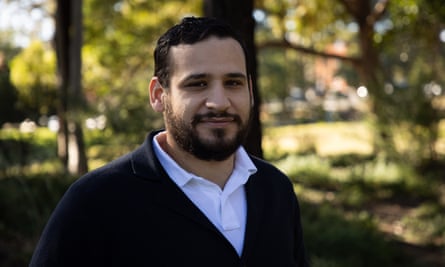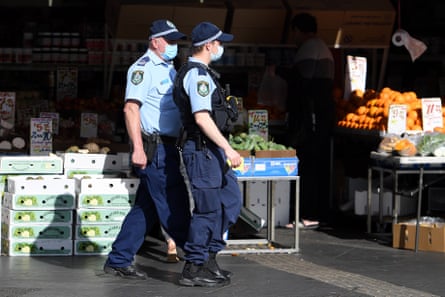On 7 July, as the situation with the Delta Covid outbreak in Sydney was deteriorating, the New South Wales premier, Gladys Berejiklian, made a very specific call out as she was announcing the first of numerous extensions to the lockdown.
She was attempting to speak to communities in western Sydney directly, urging them to heed public health orders.
“Can I say to the communities in those areas, many have a similar background to me, please don’t mingle with family. I haven’t seen my parents since the lockdown started – it is hard,” she said.
“Can I say to everybody don’t mingle with family, don’t think it is OK to visit your cousins or have sleepovers.”
The premier would go on to introduce tough restrictions for eight local government areas in western and south-western Sydney: Blacktown, Campbelltown, Canterbury-Bankstown, Cumberland, Fairfield, Georges River, Liverpool and Parramatta.
In Fairfield alone, 78% of residents have parents who were born overseas and more than 75% speak a language other than English at home. In Canterbury-Bankstown, just 34.1% of people speak only English at home and in Liverpool, just 31.1% of residents are born in Australia.
Berejiklian’s assumption that communities in these areas would resonate with a stereotype that they all had extended families they visited was perhaps insensitive, but it spoke to the government’s desperation.
They needed to get the message to communities in those suburbs – residents from varied backgrounds who speak a range of languages.
Considering the Covid outbreak’s stubborn hold on the region, it doesn’t appear the NSW government have succeeded. On 3 August, the federal government released a regional breakdown of vaccination rates, and south-west Sydney came dead last.
So the virus continues to spread and vaccination uptake has been slow. A problem that at first appears a simple one of messaging unfolds into a complex web of issues, with the pandemic shining a light through its intricate patterns.
Outdated understandings
Dr Michael Camit has seen many health campaigns in his decades as an academic and researcher in south-western Sydney. His research has focused on social media and migrants, and he says there are four traditional tenets to health communication strategies aimed at diverse communities: translation, consultation, community leaders and “culturally appropriate” media.
But he believes these tenets are being challenged by the Covid outbreak in western Sydney.
“It’s exposing the kind of things that we took for granted in decades of health communication with migrant communities. The way we have developed interventions for migrants and refugees in terms of health communication is outdated,” he says.
Camit says one of the challenges facing the government is their own conceptualisation of migrant communities, which has led them to many assumptions.
“It’s not enough to just directly translate something,” he explains. “And community leaders, while they’re very useful for newly arrived migrants, not all communities actually subscribe or follow a community leader.
“There’s [also] a tendency for the government to assume that because they are the government, people will trust them.”
It is a recurring frustration for Tareq Ahmed, a Canterbury-Bankstown resident who works to address the spread of misinformation in his community.
He uses social media to rally against anti-vaccination sentiments, and tells Guardian Australia he doesn’t even have a community leader, let alone one he’d take health advice from.
“What I see from authorities is, they say, OK, we’re gonna translate, translate, translate. We’ll cherry-pick a community leader or randomly pick whoever we’ve worked with previously and get them to start promoting the vaccination and the testing. That’s it. And when you do that, you leave quite a few people out.”
Ahmed says the government’s strategy leaves too many people behind and lumps different communities into a homogenous group.

Voids and mass confusion
These misunderstandings of how leadership and communication work in diverse communities have created a void – a black hole of misinformation and fear.
Where there should be trust in authorities and science, there is paranoia at tough policing measures, confusion at the changing restrictions and health messaging that is just not cutting through.
To Ahmed, perhaps the best example of that was seeing Sky News anchor Alan Jones’ anti-lockdown videos being shared around his social circle.
“You’ve got quite the task on your hands if you’ve got people from within our community echoing Alan Jones. That means you need to pick up your game.”
Jones’ views have in the past been abhorred by the many in the community. In a ruling from the Australian Communications and Media Authority, Jones was found to have racially vilified and encouraged violence toward Lebanese and Middle Eastern in the lead-up to the 2005 Cronulla riots.
Prof Andre Renzaho from the Translational Health Research Institute at Western Sydney University says the proliferation of fake news has exacerbated vaccine hesitancy in migrant communities.

“The fake news among migrant communities has been travelling faster than the pandemic, and many of the migrants are digitally illiterate – that is, unable to evaluate information from social media to authenticate its source, accuracy and relevance.”
Renzaho argues it is not the characteristics of migrant communities that have led them to this point, but rather a failure of government to better understand their needs and allocate the necessary resources.
“The issue is not migrants’ reluctance to embrace the diversity of immunisation programs … but the failure of the systems and health policies to put in place culturally competent programs geared towards increasing migrants’ vaccination literacy,” Renzaho says.
He says it isn’t actually about a general distrust in authority, notwithstanding the region’s history of being overpoliced. Instead, he says, the distrust itself is a reflection of government failure.
“When migrant communities are feeling excluded, lost in translation, they get frustrated and their frustration can easily be misconstrued as distrusting authorities, but in my case it is more about scapegoating vulnerable communities when government initiatives and service providers fail to meet their needs.”
Camit says the government’s reliance on “traditional” techniques of health communication aimed at diverse communities had not accounted for social media and the agency of recipients.
There isn’t an acknowledgment of the many sources of news and authority figures people may have, or of the influence that family and media overseas plays, or even of the ways people trust their families more than they do politicians.
“There’s a lack of acknowledgment that the end user is not just sitting there listening and saying, ‘Oh, yes. OK. I’ll follow that.’ Because of the fragmentation of media, it’s your peers that influence you. People who look like you, people who you know, who you live with.”
A top-down approach
Camit characterises the approach by authorities as a “top-down” approach, saying it is “paternalistic” and doesn’t take into account community voices and their need for a nuanced approach.
He says it is not that diverse communities have a misinformation problem, but that the needs of these communities are not being recognised, let alone met.
“We’re dealing with a complex virus. But the complexity of the audience you’re working with hasn’t really been acknowledged.”
Renzaho lays it out more directly, saying many of these issues are rooted in structural racism in the ways it ripples out over time and affects communities.
“Structural racism can be linked to many factors such as historical unethical and harmful practices, cultural blindness in service delivery, maltreatment and discrimination in the healthcare, poor vaccination literacy and associated perceived concerns about vaccine effectiveness and potential harms,” Renzaho says.
“Certain migrants may use a combination of these factors to develop vaccination hesitancy if proper programs are not put in place to increase their vaccination literacy and ensure they are well informed.”

Too little, too late
To Ahmed, these are issues the government had time to identify and address.
“We always wait until there’s a catastrophe or crisis before we start working on this trust issue. You need to do a better job of building relationships with different communities.”
To him, the fact Sydney is even at this point is lamentable. Now his community is facing the horrors of the disease head-on, with infection being the only way some are convinced of its dangers.
“It’s not fair that people have to experience it first hand to know that Covid is dangerous. I don’t think that message is going out well enough.”
Quick GuideHow to get the latest news from Guardian Australia
Show

Email: sign up for our daily morning and afternoon email newsletters
App: download our free app and never miss the biggest stories
Social: follow us on YouTube, TikTok, Instagram, Facebook or Twitter
Podcast: listen to our daily episodes on Apple Podcasts, Spotify or search "Full Story" in your favourite app
